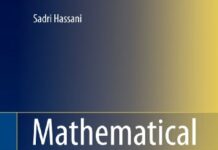
Ebook Info
- Published: 2003
- Number of pages: 250 pages
- Format: PDF
- File Size: 6.09 MB
- Authors: Sadri Hassani
Description
Intended as a companion for textbooks in mathematical methods for science and engineering, this book presents a large number of numerical topics and exercises together with discussions of methods for solving such problems using Mathematica(R). Although it is primarily designed for use with the author’s “Mathematical Methods: For Students of Physics and Related Fields,” the discussions in the book sufficiently self-contained that the book can be used as a supplement to any of the standard textbooks in mathematical methods for undergraduate students of physical sciences or engineering.
User’s Reviews
Editorial Reviews: Review From the reviews:”From a stylistic perspective the book strikes a comfortable balance between explanation and example which makes it easy to dip into and attractive to work through. For the eager reader there is always the promise of an interesting result after half an hour of labour. … The target audience of this book is likely to be a Physics undergraduate finishing his or her first year of study.” (Dr. E. J. Grace, Contemporary Physics, Vol. 45 (2), 2004)”Initially this book has been designed as a companion to the undergraduate textbook ‘Mathematical methods’ … and later on developed into a self-contained introduction to the use of computer algebra system (CAS) Mathematica tailored specifically for undergraduate students in physics and related fields. … The book is written in a transparent manner and does not require any prior knowledge of physics for mastering computational techniques. … thanks to a massive array of carefully selected and nicely explained examples from undergraduate physics.” (Yuri V. Rogovchenko, Zentralblatt MATH, Vol. 1028, 2004)”This book is intended to be a companion for textbooks in mathematical methods for undergraduate science and engineering students. It presents a number of numerical topics and exercises together with discussions of methods needed for solving problems with Mathematica. … In conclusion, this very well produced and illustrated book is heartily recommended … .” (André Hautot, Gary J. Long, Physicalia, Vol. 26 (1), 2004)
Reviews from Amazon users which were colected at the time this book was published on the website:
⭐I found the book to be very clear, and gives just enough of an explanation and examples to get one started and exploring. It certainly does not lead you by the hand, yet the author manages to pack in a lot of information. I found it to be one of the best introductions to Mathematica and higly recommend it to any science or math major.
Keywords
Free Download Mathematical Methods Using Mathematica®: For Students of Physics and Related Fields (Undergraduate Texts in Contemporary Physics) 2003rd Edition in PDF format
Mathematical Methods Using Mathematica®: For Students of Physics and Related Fields (Undergraduate Texts in Contemporary Physics) 2003rd Edition PDF Free Download
Download Mathematical Methods Using Mathematica®: For Students of Physics and Related Fields (Undergraduate Texts in Contemporary Physics) 2003rd Edition 2003 PDF Free
Mathematical Methods Using Mathematica®: For Students of Physics and Related Fields (Undergraduate Texts in Contemporary Physics) 2003rd Edition 2003 PDF Free Download
Download Mathematical Methods Using Mathematica®: For Students of Physics and Related Fields (Undergraduate Texts in Contemporary Physics) 2003rd Edition PDF
Free Download Ebook Mathematical Methods Using Mathematica®: For Students of Physics and Related Fields (Undergraduate Texts in Contemporary Physics) 2003rd Edition


